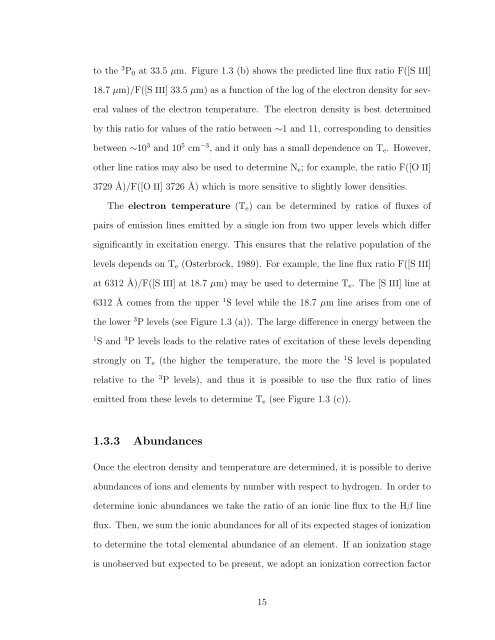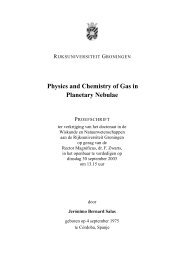TRACING ABUNDANCES IN GALAXIES WITH THE SPITZER ...
TRACING ABUNDANCES IN GALAXIES WITH THE SPITZER ...
TRACING ABUNDANCES IN GALAXIES WITH THE SPITZER ...
You also want an ePaper? Increase the reach of your titles
YUMPU automatically turns print PDFs into web optimized ePapers that Google loves.
to the 3 P0 at 33.5 µm. Figure 1.3 (b) shows the predicted line flux ratio F([S III]<br />
18.7 µm)/F([S III] 33.5 µm) as a function of the log of the electron density for sev-<br />
eral values of the electron temperature. The electron density is best determined<br />
by this ratio for values of the ratio between ∼1 and 11, corresponding to densities<br />
between ∼10 3 and 10 5 cm −3 , and it only has a small dependence on Te. However,<br />
other line ratios may also be used to determine Ne; for example, the ratio F([O II]<br />
3729 ˚A)/F([O II] 3726 ˚A) which is more sensitive to slightly lower densities.<br />
The electron temperature (Te) can be determined by ratios of fluxes of<br />
pairs of emission lines emitted by a single ion from two upper levels which differ<br />
significantly in excitation energy. This ensures that the relative population of the<br />
levels depends on Te (Osterbrock, 1989). For example, the line flux ratio F([S III]<br />
at 6312 ˚A)/F([S III] at 18.7 µm) may be used to determine Te. The [S III] line at<br />
6312 ˚A comes from the upper 1 S level while the 18.7 µm line arises from one of<br />
the lower 3 P levels (see Figure 1.3 (a)). The large difference in energy between the<br />
1 S and 3 P levels leads to the relative rates of excitation of these levels depending<br />
strongly on Te (the higher the temperature, the more the 1 S level is populated<br />
relative to the 3 P levels), and thus it is possible to use the flux ratio of lines<br />
emitted from these levels to determine Te (see Figure 1.3 (c)).<br />
1.3.3 Abundances<br />
Once the electron density and temperature are determined, it is possible to derive<br />
abundances of ions and elements by number with respect to hydrogen. In order to<br />
determine ionic abundances we take the ratio of an ionic line flux to the Hβ line<br />
flux. Then, we sum the ionic abundances for all of its expected stages of ionization<br />
to determine the total elemental abundance of an element. If an ionization stage<br />
is unobserved but expected to be present, we adopt an ionization correction factor<br />
15













